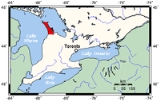
Bruce Peninsula
Encyclopedia
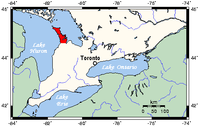
Peninsula
A peninsula is a piece of land that is bordered by water on three sides but connected to mainland. In many Germanic and Celtic languages and also in Baltic, Slavic and Hungarian, peninsulas are called "half-islands"....
in Ontario
Ontario
Ontario is a province of Canada, located in east-central Canada. It is Canada's most populous province and second largest in total area. It is home to the nation's most populous city, Toronto, and the nation's capital, Ottawa....
, Canada
Canada
Canada is a North American country consisting of ten provinces and three territories. Located in the northern part of the continent, it extends from the Atlantic Ocean in the east to the Pacific Ocean in the west, and northward into the Arctic Ocean...
that lies between Georgian Bay
Georgian Bay
Georgian Bay is a large bay of Lake Huron, located entirely within Ontario, Canada...
and the main basin of Lake Huron
Lake Huron
Lake Huron is one of the five Great Lakes of North America. Hydrologically, it comprises the larger portion of Lake Michigan-Huron. It is bounded on the east by the Canadian province of Ontario and on the west by the state of Michigan in the United States...
. The peninsula extends roughly northwestwards from the rest of Southern Ontario
Southern Ontario
Southern Ontario is a region of the province of Ontario, Canada that lies south of the French River and Algonquin Park. Depending on the inclusion of the Parry Sound and Muskoka districts, its surface area would cover between 14 to 15% of the province. It is the southernmost region of...
, pointing towards Manitoulin Island
Manitoulin Island
Manitoulin Island is a Canadian island in Lake Huron, in the province of Ontario. It is the largest island in a freshwater lake in the world. In addition to the historic Anishinaabe and European settlement of the island, archeological discoveries at Sheguiandah have demonstrated Paleo-Indian and...
, with which it forms the widest strait
Strait
A strait or straits is a narrow, typically navigable channel of water that connects two larger, navigable bodies of water. It most commonly refers to a channel of water that lies between two land masses, but it may also refer to a navigable channel through a body of water that is otherwise not...
joining Georgian Bay to the rest of Lake Huron. The Bruce Peninsula contains part of the geological formation known as the Niagara Escarpment
Niagara Escarpment
The Niagara Escarpment is a long escarpment, or cuesta, in the United States and Canada that runs westward from New York State, through Ontario, Michigan, Wisconsin and Illinois...
.
From an administrative standpoint, the Bruce Peninsula is part of Bruce County
Bruce County, Ontario
Bruce County is a county in western Ontario, Canada, and includes the Bruce Peninsula. As of 2006, the population was 65,349. The area was . The county seat is Walkerton, Ontario. It is located at ....
, named for James Bruce, 8th Earl of Elgin
James Bruce, 8th Earl of Elgin
Sir James Bruce, 8th Earl of Elgin and 12th Earl of Kincardine, KT, GCB, PC , was a British colonial administrator and diplomat...
(Lord Elgin), Governor General of the Province of Canada
Governor General of the Province of Canada
The Governor General of the Province of Canada was the vice-regal post of pre-Confederation Canada that existed from 1840 to Canadian Confederation in 1867....
. A popular tourist destination for camping, hiking and fishing, the area has two national parks (Bruce Peninsula National Park
Bruce Peninsula National Park
Bruce Peninsula National Park is a national park on the Bruce Peninsula in Ontario, Canada. Located on a part of the Niagara Escarpment, the park comprises 156 square kilometres and is one of the largest protected areas in southern Ontario, forming the core of UNESCO's Niagara Escarpment World...
and Fathom Five National Marine Park
Fathom Five National Marine Park
Fathom Five National Marine Park is a National Marine Conservation Area in the Georgian Bay part of Lake Huron, Ontario, Canada, that seeks to protect and display shipwrecks and lighthouses, and conserve freshwater ecosystems...
), more than half a dozen nature reserves, and the Bruce Peninsula Bird Observatory. The Bruce Trail
Bruce Trail
The Bruce Trail is a hiking trail in southern and central Ontario, Canada.-General:The trail follows the edge of the Niagara Escarpment, one of the thirteen UNESCO World Biosphere Reserves in Canada, for almost...
runs through the region to its northern terminus in the town of Tobermory
Tobermory, Ontario
Tobermory is a small community located at the northern tip of the Bruce Peninsula in the municipality of Northern Bruce Peninsula, Ontario, Canada. It is 300 km northwest of Toronto...
.
The Bruce Peninsula is a key area for both plant and animal wildlife. Part of the Niagara Escarpment World Biosphere Reserve
Biosphere reserve
The Man and the Biosphere Programme of UNESCO was established in 1971 to promote interdisciplinary approaches to management, research and education in ecosystem conservation and sustainable use of natural resources.-Development:...
, the peninsula has the largest remaining area of forest and natural habitat in Southern Ontario and is home to some of the oldest trees in eastern North America. An important flyway for migrating birds, the peninsula is habitat to a variety of animals, including black bear
American black bear
The American black bear is a medium-sized bear native to North America. It is the continent's smallest and most common bear species. Black bears are omnivores, with their diets varying greatly depending on season and location. They typically live in largely forested areas, but do leave forests in...
, massasauga rattlesnake, and barred owl
Barred Owl
The Barred Owl is a large typical owl. It goes by many other names, including eight hooter, rain owl, wood owl, and striped owl, but is probably best known as the hoot owl.-Description:...
.
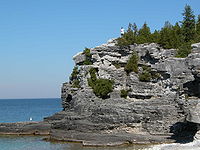
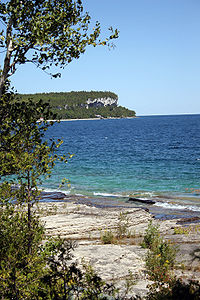
History from 19th century
Up until the mid-19th century, the area known as the Bruce Peninsula was territory controlled by the Saugeen Ojibway Nations. The nations included the Chippewas of Nawash Unceded First NationChippewas of Nawash Unceded First Nation
Chippewas of Nawash Unceded First Nation formerly "Cape Croker" is an Ojibway First Nation living on unceded territory in the Bruce Peninsula in Ontario, Canada. Along with the Saugeen First Nation, they form the Chippewas of Saugeen Ojibway Territory...
and Saugeen First Nation. Historical and archaeological evidence from the area concludes that at the time of first contact with Europeans, the peninsula was inhabited by the Odawa
Odawa people
The Odawa or Ottawa, said to mean "traders," are a Native American and First Nations people. They are one of the Anishinaabeg, related to but distinct from the Ojibwe nation. Their original homelands are located on Manitoulin Island, near the northern shores of Lake Huron, on the Bruce Peninsula in...
people, from whom a large number of local native people are descended. Oral history from Saugeen & Nawash suggests their ancestors have been here as early as 7500 years ago. The area of Hope Bay is known to natives as Nochemoweniing, or Place of Healing.
The Saugeen Ojibway signed a treaty with Sir Francis Bond Head in 1836 for lands south of the peninsula in exchange for learning agriculture, proper housing, assistance in becoming “civilized” and for permanent protection of the peninsula. In 1854, the Saugeen Ojibway were pushed into signing another treaty – this time for the peninsula. The Saugeen Ojibway launched a land claim for part of their traditional territory in 1994 – claiming breach of trust by the crown in failing to meet its treaty obligations to protect Aboriginal lands. The claim seeks the return of lands still held by the Crown and financial compensation for other lands. This claim is still active.
European settlement began on the peninsula in the mid 19th century. Despite its poor potential for agricultural development; attracted by the rich fisheries and lush forest, settlers found the land known then as the “Indian or Saugeen Peninsula” to be irresistible. In 1881 – the first sawmill appeared on the peninsula in Tobermory
Tobermory, Ontario
Tobermory is a small community located at the northern tip of the Bruce Peninsula in the municipality of Northern Bruce Peninsula, Ontario, Canada. It is 300 km northwest of Toronto...
. In less than 20 years most of the valuable timber was gone. Fuelled by the waste left behind by the rapid logging and land clearances – intense fires sprung up around the peninsula. By the mid 1920’s abundant forests of the peninsula were nearly barren. When the lamprey eel was introduced to the Great Lakes
Great Lakes
The Great Lakes are a collection of freshwater lakes located in northeastern North America, on the Canada – United States border. Consisting of Lakes Superior, Michigan, Huron, Erie, and Ontario, they form the largest group of freshwater lakes on Earth by total surface, coming in second by volume...
in 1932 – the devastation on the fish supply made the peninsula a less attractive place for settlers, and many left when fish stocks were depleted. The peninsula would continue a steady decline in population until the 1970s. The peninsula did start to attract a new kind of settler – the cottager. Today – seasonal residents out-number permanent residents.
Natural History of the Bruce Peninsula & the Niagara Escarpment
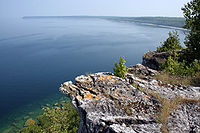
The Niagara Escarpment has origins dating back into the Silurian
Silurian
The Silurian is a geologic period and system that extends from the end of the Ordovician Period, about 443.7 ± 1.5 Mya , to the beginning of the Devonian Period, about 416.0 ± 2.8 Mya . As with other geologic periods, the rock beds that define the period's start and end are well identified, but the...
age some 430 to 450 million years ago, a time when the area lay under a shallow warm sea. This sea lay in a depression of the Earth's crust, centred in what is now the lower peninsula of the State of Michigan. Known geologically as the Michigan Basin, the outer rim of this massive saucer-shaped feature governs the location of the Niagara Escarpment. In the shape of a gigantic horseshoe the Escarpment can be traced from near Rochester, New York, south of Lake Ontario to Hamilton, north to Tobermory on the Bruce Peninsula, beneath the waters of Lake Huron to appear again on Manitoulin Island, across northern Michigan and down the west side of Lake Michigan into the State of Wisconsin.
As occurs with present day water bodies such as Hudson Bay or the Gulf of Mexico, rivers flowing into this ancient sea carried sand, silt and clay to be deposited as thick layers of sediment. At the same time lime-rich organic material from the abundant sea life was also accumulating. Over millions of years these materials became compressed into massive layers of sedimentary rocks and ancient reef structures now visible along the Escarpment. Some rock layers now consist of soft shales and sandstones while others are made up of dolostone (a rock similar to limestone which contains magnesium and is more durable).
Today, fossil remains illustrating the various life forms can be found in many of the rocks as they are slowly exposed by the action of wind, water and ice.
Native History
Saugeen First Nation is an OjibwaOjibwa
The Ojibwe or Chippewa are among the largest groups of Native Americans–First Nations north of Mexico. They are divided between Canada and the United States. In Canada, they are the third-largest population among First Nations, surpassed only by Cree and Inuit...
First Nation located along the Saugeen River
Saugeen River
The Saugeen River is located in southern Ontario, Canada, flowing generally north-west about 160 km before exiting into Lake Huron. The river is navigable for some distance, and was once an important barge route...
and Bruce Peninsula in Ontario, Canada. Organized in the mid 1970s, Saugeen First Nation declares itself the primary political successor apparent to the Chippewas of Saugeen Ojibway Territory
Chippewas of Saugeen Ojibway Territory
Saugeen First Nation is an Ojibway First Nation located along the Saugeen River and Bruce Peninsula in Ontario, Canada. Organized in the mid 1970s, Saugeen First Nation is the primary political successor apparent to the Chippewas of Saugeen Ojibway Territory....
. However, along with the Saugeen First Nation, Chippewas of Nawash Unceded First Nation
Chippewas of Nawash Unceded First Nation
Chippewas of Nawash Unceded First Nation formerly "Cape Croker" is an Ojibway First Nation living on unceded territory in the Bruce Peninsula in Ontario, Canada. Along with the Saugeen First Nation, they form the Chippewas of Saugeen Ojibway Territory...
also claims as political successor apparent to the Chippewas of Saugeen Ojibway Territory. The original territory included all of the Saugeen River watershed and all of the Bruce Peninsula. Under the Saugeen Tract Agreement
Saugeen Tract Agreement
Saugeen Tract Agreement, registered as Crown Treaty Number 45, was signed August 9, 1836 between the Saugeen Ojibwa and Ottawa and the government of Upper Canada...
, the portion south of Owen Sound was ceded to the Crown
The Crown
The Crown is a corporation sole that in the Commonwealth realms and any provincial or state sub-divisions thereof represents the legal embodiment of governance, whether executive, legislative, or judicial...
, with reserves later established on the Bruce Peninsula.
Parks
There are 2 National Parks, 8 Ontario Parks and 4 Federation of Ontario Naturalists Parks located within the Bruce Peninsula.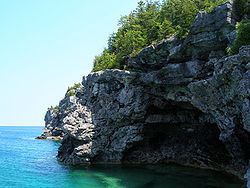
- Bruce Peninsula National ParkBruce Peninsula National ParkBruce Peninsula National Park is a national park on the Bruce Peninsula in Ontario, Canada. Located on a part of the Niagara Escarpment, the park comprises 156 square kilometres and is one of the largest protected areas in southern Ontario, forming the core of UNESCO's Niagara Escarpment World...
http://www.pc.gc.ca/pn-np/on/bruce/index_e.asp - In the heart of a World Biosphere Reserve, the park contains massive, rugged cliffs inhabited by thousand year old cedar trees. The park is composed of an array of habitats from alvarAlvarAn alvar is a biological environment based on a limestone plain with thin or no soil and, as a result, sparse vegetation. It is also known as a pavement barren although this term is also used for similar landforms based on sandstone. In the United Kingdom the exposed landform is called a limestone...
s to dense forests and several small lakes. Together these form a greater ecosystem - the largest remaining chunk of natural habitat in southern Ontario.
- Fathom Five National Marine ParkFathom Five National Marine ParkFathom Five National Marine Park is a National Marine Conservation Area in the Georgian Bay part of Lake Huron, Ontario, Canada, that seeks to protect and display shipwrecks and lighthouses, and conserve freshwater ecosystems...
http://www.pc.gc.ca/amnc-nmca/on/fathomfive/index_E.asp - The waters at the mouth of Georgian Bay are home to Fathom Five - Canada's first National Marine Conservation Area. The park preserves 22 shipwrecks and several historic light stations. Fathom Five’s freshwater ecosystem contains some of the most pristine waters of the Great Lakes. The park contains rugged lake bed topography that is popular with scuba divers.
Ontario Parks
Ontario Parks
Ontario Parks is the branch of the Ministry of Natural Resources that administers the provincial parks in Ontario, Canada. The Ontario Parks system covers over 78,000 square kilometres , about 10 percent of the province's surface area or the equivalent of an area approximately equal to Nova Scotia...
http://www.ontarioparks.com/english/welcome.html - include:
- Black Creek http://www.ontarioparks.com/english/blac.html
- Ira Lake http://www.ontarioparks.com/english/ira.html
- Johnstons Harbour http://www.ontarioparks.com/english/johns.html
- Little Cove http://www.ontarioparks.com/english/littc.html
- Cabot Head http://www.ontarioparks.com/english/cabo.html
- Smoky Head http://www.ontarioparks.com/english/smok.html
- Lion's Head http://www.ontarioparks.com/english/lion.html
- Hope Bay Forest http://www.ontarioparks.com/english/hope.html
Federation of Ontario Naturalists http://www.ontarionature.org/index.php3 - Ontario Nature works to protect and restore the species, spaces and landscapes that represent the full diversity of nature in Ontario.
Lighthouses of the Bruce Peninsula
The Bruce Peninsula's shoreline has several lighthouses, necessary to provide guidance to the many ships that would pass by her shores.The Cove Island Light, located near Tobermory is one of the six famous "Imperial" lighthouses built in the 1850s by John Brown which can be found on the mainland and on nearby islands of the northern Bruce Peninsula.
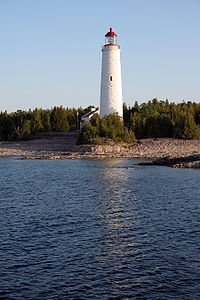
- Lion's Head LighthouseLion's Head LighthouseLion's Head Lighthouse is a lighthouse on Georgian Bay, Ontario, Canada near the village of Lion's Head.-Sources:*...
- Flowerpot Island
- Big Tub Lighthouse
- Knife & Lyal Island Lighthouse
- Cape Croker Lighthouse
- Cabot Head Lighthouse
Wildlife
There are many varieties of wildlife on the Bruce Peninsula, such as the northern flying squirrelNorthern Flying Squirrel
The Northern flying squirrel is one of two species of the genus Glaucomys, the only flying squirrels found in North America . Unlike most members of their family, flying squirrels are strictly nocturnal...
, black bear
American black bear
The American black bear is a medium-sized bear native to North America. It is the continent's smallest and most common bear species. Black bears are omnivores, with their diets varying greatly depending on season and location. They typically live in largely forested areas, but do leave forests in...
, chipmunk
Chipmunk
Chipmunks are small striped squirrels native to North America and Asia. They are usually classed either as a single genus with three subgenera, or as three genera.-Etymology and taxonomy:...
, fisher, long-eared bats, red squirrel, fox, massasauga rattlesnake, red-shouldered hawk
Red-shouldered Hawk
The Red-shouldered Hawk is a medium-sized hawk. Its breeding range spans eastern North America and along the coast of California and northern to northeastern-central Mexico.-Description:...
, barred owl
Barred Owl
The Barred Owl is a large typical owl. It goes by many other names, including eight hooter, rain owl, wood owl, and striped owl, but is probably best known as the hoot owl.-Description:...
, hermit thrush
Hermit Thrush
The Hermit Thrush is a medium-sized North American thrush. It is not very closely related to the other North American migrant species of Catharus, but rather to the Mexican Russet Nightingale-thrush.-Description:...
, black-throated blue warbler, scarlet tanager
Scarlet Tanager
The Scarlet Tanager is a medium-sized American songbird. Formerly placed in the tanager family , it and other members of its genus are now classified in the cardinal family . The species's plumage and vocalizations are similar to other members of the cardinal family.-Description:Adults have pale...
and yellow-spotted salamander
Salamander
Salamander is a common name of approximately 500 species of amphibians. They are typically characterized by a superficially lizard-like appearance, with their slender bodies, short noses, and long tails. All known fossils and extinct species fall under the order Caudata, while sometimes the extant...
.
The Bruce Peninsula is located on a major northern migration route, so many species of birds, such as the bald eagle, have their wintering grounds here.
The highest concentration of nesting birds can be found in the Bruce in May and June each year. About 20 species of warblers breed on "the Bruce" including the Black-throated Green, Yellow, Yellow-rumped, and Blackburnian Warblers and the ubiquitous American Redstart. They make their summer homes in the extensive wooded areas along the Peninsula. The annual Huron Fringe Birding Festival in May observes the spring migration. The endangered Piping Plover has made a come-back along the northern shores of Sauble Beach as well, and nest in restricted areas of the beach that are well marked to reduce negative impact on the species.
Migrating hawks also follow the Niagara Escarpment. Hawks travel during the day, and can be in the vicinity of Cabot Head in the open areas west of Dyers Bay, and near Tobermory, in April.
Wildflowers & Orchids

Lakeside Daisy (hymenoxys acaulis var. glabra), Dwarf Lake Iris
Dwarf Lake Iris
The Dwarf Lake Iris is a beardless rhizomatous iris native to the northern shores of Lake Michigan and Lake Huron....
(iris lacustris), Northern Holly Fern (polypodium lonchitis)
Orchids
Globally, there are more than 30,000 orchid species. Canada is home to 77 of these species. Ontario has 61 varieties of orchids, and of these, 44 can be found in the Bruce Peninsula.A selection of interesting orchids on the Bruce Peninsula:
Yellow Lady's Slipper — Cypripedium parviflorum
Cypripedium parviflorum
Cypripedium parviflorum, commonly known as Yellow Lady's Slipper or Mocassin Flower is a Lady's Slipper orchid found in North America.-External links:* * , Digital Flora of Newfoundland and Labrador...
Nodding Ladies' Tresses — Spiranthes cernua
Spiranthes cernua
Spiranthes cernua, commonly called the Nodding Ladies'-tresses, is a species of orchid occurring from eastern Canada to the central and eastern United States....
Eastern Prairie Fringed Orchid
Eastern Prairie Fringed Orchid
Platanthera leucophaea, commonly known as the Eastern Prairie Fringed Orchid, is a rare species of orchid native to North America. While it is listed as a threatened species in the United States on September 28, 1989, the IUCN does not recognise it as being at risk.P. leucophaea arises from a...
— Platanthera leucophaea
Ram's-Head Lady's-Slipper — Cypripedium arietinum
Cypripedium arietinum
The rare Ram's-Head Lady's-Slipper is an orchid that is native to the alvars around the Great Lakes in North America.The plant grows to 10-40 cm , and the flowers may reach 1-2 cm...
European Common Twayblade — Listera ovata
Helleborine
Epipactis
Epipactis, or Helleborine, is a genus of terrestrial orchids consisting of approximately 70 species. This genus is abbreviated as Epcts in horticultural trade.They occur in temperate and subtropical climates of America, Asia, and Europe...
— Epipactis helleborine
Epipactis helleborine
Epipactis helleborine is a European orchid that has been introduced to several regions of North America. Its nodding flowers vary from greenish pink to purple, and it prefers shaded woodland environments. More information on this species and others of the genus are at Epipactis.-External links:*...
Communities
The Bruce Peninsula is composed of the Municipalities of Northern Bruce PeninsulaNorthern Bruce Peninsula, Ontario
The Municipality of Northern Bruce Peninsula is located on the Bruce Peninsula in Ontario, Canada. It is a popular vacation spot in the summer for its water sports and cottaging and in the winter for the snowmobiling....
and South Bruce Peninsula
South Bruce Peninsula, Ontario
South Bruce Peninsula is a town at the base of the Bruce Peninsula of Ontario, Canada, in the County of Bruce between Lake Huron and Georgian Bay.Recently the cottage industry has become the major industry in the area...
.
The main villages in these regions are as follows:
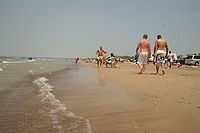
- TobermoryTobermory, OntarioTobermory is a small community located at the northern tip of the Bruce Peninsula in the municipality of Northern Bruce Peninsula, Ontario, Canada. It is 300 km northwest of Toronto...
- Located at the northern end of the Bruce Peninsula, Tobermory http://www.thebrucepeninsula.com/tobermory is home to the passenger-car ferry MS Chi-Cheemaun, and nearby Bruce Peninsula National Park and Fathom Five National Marine Park. This port village has galleries, tourist shops and a historic lighthouse.
- Lion's HeadLion's Head, OntarioLion's Head is a community in the municipality of North Bruce Peninsula, Bruce County, Ontario, Canada. Located at the midway point of the Bruce Peninsula, about halfway between Owen Sound and Tobermory, Lion's Head is just east of Ferndale on Bruce Road 9. Lion's Head is located on the 45th...
- Located in the centre of the Bruce Peninsula on Georgian Bay is the port town of Lion's Head http://www.thebrucepeninsula.com/lionshead. The village has a public marina and sandy beach.
- WiartonWiarton, OntarioWiarton is a community in Bruce County, Ontario, at the western end of Colpoys Bay, an inlet off Georgian Bay, on the Bruce Peninsula. The community is part of the town of South Bruce Peninsula, Ontario....
- Near the south end of the peninsula is Wiarton, http://www.thebrucepeninsula.com/wiarton, home of Wiarton WillieWiarton WillieWiarton Willie is a famous albino Canadian groundhog who lived in the community of Wiarton in Bruce County, Ontario. Every February 2, on Groundhog Day, Willie took part in the local Wiarton Willie Festival. His role is to predict whether there will be an early spring...
- Sauble BeachSauble Beach, OntarioSauble Beach, Ontario, Canada is a resort community and unincorporated area in the town of South Bruce Peninsula, Bruce County in southwestern Ontario, Canada. It is on the eastern shore of Lake Huron, on the north edge of the Saugeen Nation...
- Sauble Beach http://www.saublebeach.com/ boasts a beach over seven miles long (11 km)
At the South end of The Bruce, Highway 86 (speed 90 km/h (56 mph)), ending at Amberley, Ontario generally denotes Huron County (to the South) from Bruce County (to the North) Counties.

